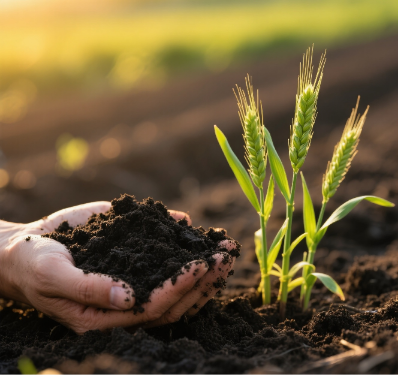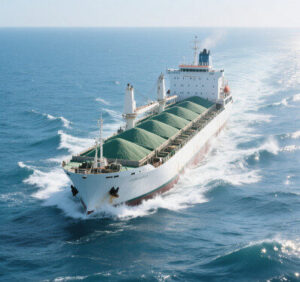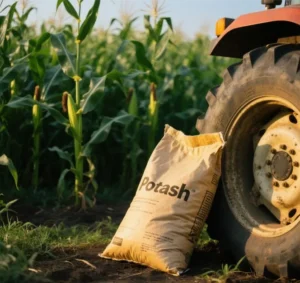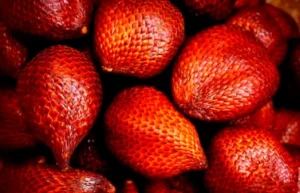Soil organic matter (SOM), a complex matrix of carbon-rich compounds derived from plant, animal, and microbial remains, plays a pivotal role in the health and productivity of terrestrial ecosystems. Though often overlooked, SOM is essential for soil fertility, nutrient cycling, and environmental resilience. This article delves into the nature, functions, and management of SOM, highlighting its significance for agriculture and beyond.
Defining Soil Organic Matter: A Dynamic Mosaic
SOM exists in two primary forms: Particulate organic matter (POM), which consists of fresh residues larger than 2 mm, and mineral-associated organic matter (MAOM), which forms stable complexes with clay minerals. POM is a readily available source of nutrients for soil microbes and contributes to soil structure and porosity. MAOM, on the other hand, plays a crucial role in enhancing soil fertility and stability by binding with minerals to form stable complexes. The broad definition encompasses all soil carbon compounds, while the narrow focus centers on humic substances—transformed remnants with high molecular weights (2,000–300,000 Da) and aromatic structures. Humic substances are rich in carbon (52-58%), oxygen (34-39%), nitrogen (3.7-4.1%), and trace elements. They have a characteristic C/N ratio of 10-12, which indicates their stability.
Sources and inputs: Fueling SOM’s Engine
In natural ecosystems, soil organic matter (SOM) accumulation is fueled by litterfall (2-12 Mg/ha/year in forests), root exudates (10-40% of photosynthates), microbial necromass (up to 50% of total SOM), and mycorrhizal networks (15-65% of plant carbon allocation). In contrast, agricultural systems rely on crop residues (e.g., 4-6 Mg/ha from wheat), animal manures (with 40-70% carbon retention), green manures (with a C/N ratio of 15-30:1), and emerging sources such as biochar (which sequesters 10-50% of feedstock carbon) and composted waste (with humification indices greater than 30). These inputs drive the dynamic balance of SOM between decomposition and stabilization.
Transformation and Stabilization: Balancing Act
The fate of SOM hinges on decomposition rates: Labile fractions mineralize rapidly (k > 0.1 yr⁻¹), while recalcitrant components persist (k < 0.01 yr⁻¹). Only 10-30% of the initial carbon transforms into stable humus through microbial processes. Long-term persistence is facilitated by organo-mineral complexes: iron and aluminum oxides protect carbon for centuries, and clay interlayers, especially smectites, immobilize organic molecules. Chemical bonding, such as ligand exchange (ΔG° = -15 to -25 kJ/mol) and cation bridging (Ca²⁺ > Mg²⁺), stabilizes these associations further.
Ecological Functions: Beyond Fertility
Soil Organic Matter (SOM)’s benefits extend far beyond soil health.
- Nutrient Cycling: It acts as a reservoir, releasing 2-5% of total nitrogen annually and increasing phosphorus availability by 30-50% through solubilization.
- Physical Protection: An increase of 1% in SOM boosts water holding capacity by 15-25% and aggregate stability (MWDP) by 2-3 times, thereby reducing erosion risks.
- Environmental Defense: SOM absorbs pesticides 10-100 times more efficiently than mineral surfaces and binds with heavy metals (log K = 4-8 for Cu²⁺/Pb²⁺), which mitigates contamination. Importantly, SOM sequesters 0.1-1.0 Mg C/ha/year, offsetting CO₂ emissions.
Strategic Management for SOM Enhancement
Sustainable practices are essential:
- Input Optimization: Minimize tillage (increasing SOM by 0.1-0.3% annually), adopt cover crops (adding 1-3 Mg C/ha/year), and apply compost (10-20 Mg/ha biennially) or biochar (5-20 Mg/ha in one application).
- Microbial Management: Promote mycorrhizal colonization to reach a target of 30-60%, as well as the growth of lignin-degrading fungi (e.g., Phanerochaete spp.). Maintain enzyme activity (β-glucosidase >100 nmol/g/h) and metabolic balance (qCO₂: 0.5-2.0 mg CO₂-C/mg MBC/h).
Monitoring and Innovation: Precision Tools
Assessing soil organic matter (SOM) requires the use of advanced techniques to gain a thorough understanding of its composition and properties, including three primary methods.
- Physical Fractionation: This technique uses density separation, typically targeting a range of 1.6–1.8 g/cm³ for mineral-associated organic matter (MAOM). It effectively separates SOM based on density, enabling the study of specific fractions. However, it may not fully capture the complexity of SOM’s associations with minerals.
- Chemical oxidation uses chemicals like sodium hypochlorite (NaOCl) to oxidize and measure the resistant carbon fraction, providing insights into recalcitrant organic matter. The advantage is its simplicity; however, it may underestimate the total SOM due to incomplete oxidation.
- Spectroscopy: Techniques such as Fourier transform infrared spectroscopy (FTIR) at 1630 cm⁻¹ and carbon-13 nuclear magnetic resonance (¹³C NMR) for determining alkyl/O-alkyl ratios offer detailed, molecular-level information. FTIR is rapid and non-destructive, but it may require careful interpretation due to potential signal overlaps. ¹³C NMR provides high resolution, but it can be time-consuming and expensive.
In practical applications, physical fractionation is suitable for studying specific soil organic matter (SOM) fractions, but it may overlook complex interactions. Chemical oxidation is a simple approach, but it may not account for the total SOM. Spectroscopic methods provide detailed molecular insights, but they can be costly and time-consuming. Understanding the advantages and limitations of these methods is key to selecting the most appropriate one for a given research or agricultural scenario.
Critical thresholds of SOM vary depending on soil types and land use. For example, arable soils in temperate regions typically require over 2.0% SOM, whereas grasslands require more than 3.5%. Quality indices, such as the humification degree (HLIFS > 0.5) and the microbial quotient (MBC/TOC > 2.5%), can also help evaluate soil health.
Despite their individual drawbacks, these methods collectively provide valuable insights into SOM dynamics, enabling better management and conservation strategies.
Conclusion: A Holistic Vision
SOM is not just soil matter — it’s the lifeblood of agriculture and climate resilience. An increase of 1% in SOM can enhance water infiltration by 25-30%, reduce the need for fertilizers by 20-30%, and sequester 8-12 tons of CO₂ per hectare. Future management must embrace systems-based approaches that integrate organic inputs with precision fertilization and leverage isotope tracing and molecular tools to optimize SOM across diverse landscapes. As global challenges mount, nurturing SOM is not just an option—it’s a necessity for ensuring food security and practicing environmental stewardship.









